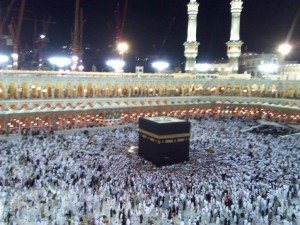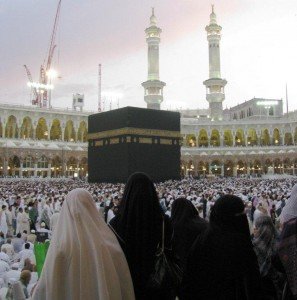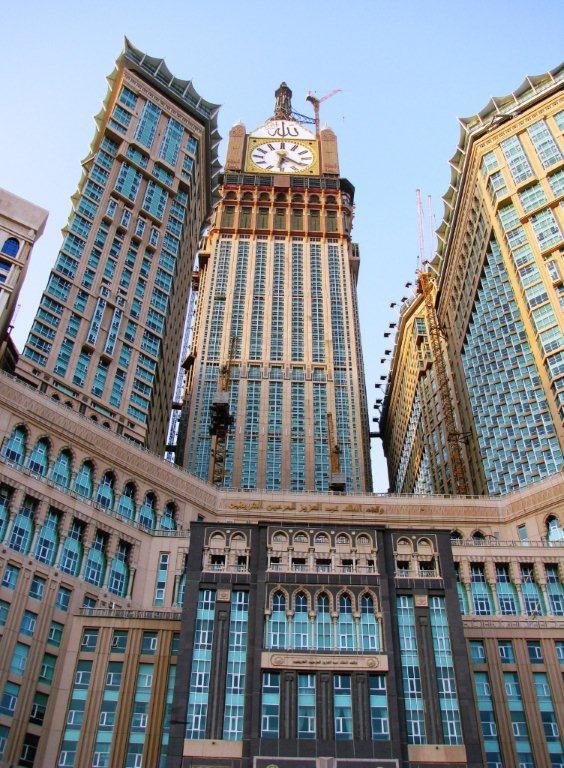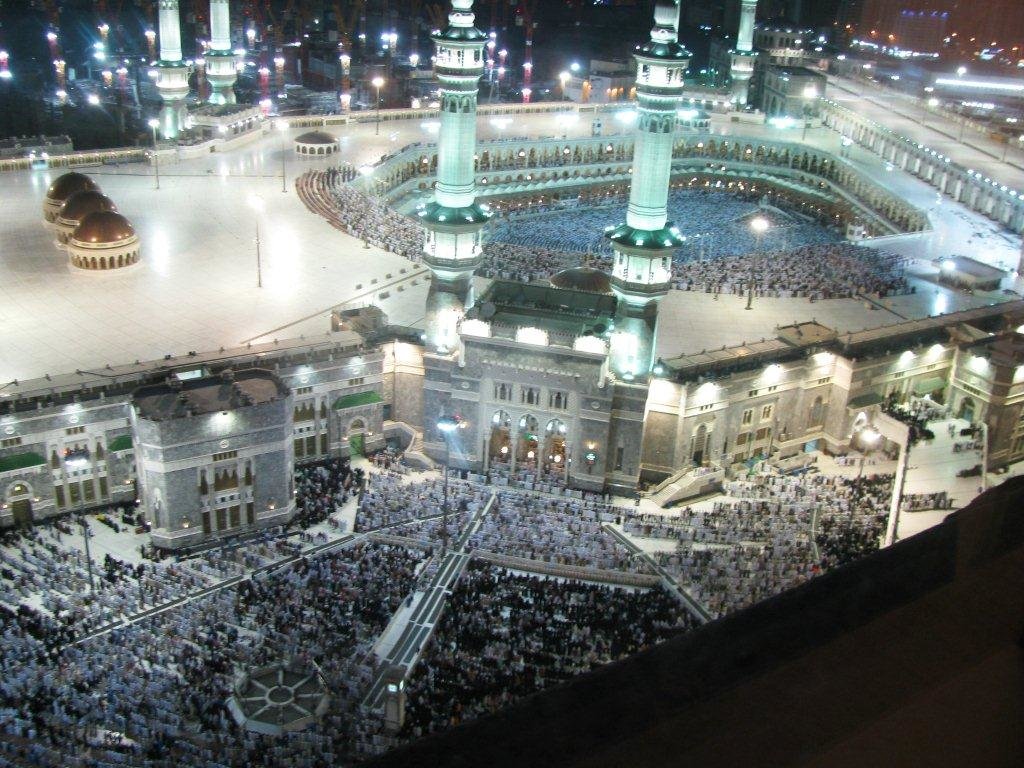My Umrah
We arrived in Mecca in the evening.
My day had started in Dubai at 6:00 AM when I rose to get the kids off to school and to pack for Umrah— a trip similar to Hajj but shorter and performed at no specific time. While Hajj is a huge, annual event that takes days, Umrah requires only several hours. I thought of it as “Hajj Lite.”
On the airplane I skimmed over my “Guide to Umrah,” a printout from the internet that explained the ritual, what to do and what to say.
 I could grasp the four main steps: 1. Purify oneself and make intentions, 2. Circle the Ka’bah seven times, 3. Walk seven times between two geographic points (full of symbolic meaning), and 4. Conclude the Umrah.
I could grasp the four main steps: 1. Purify oneself and make intentions, 2. Circle the Ka’bah seven times, 3. Walk seven times between two geographic points (full of symbolic meaning), and 4. Conclude the Umrah.
Flying somewhere over Saudi, we made our intentions and murmured some phrases in Arabic. Half the passengers were doing the same. The male pilgrims—from the boys to the old men—were dressed in two sheets of white cloth, one around the waist and the other over the shoulder. Thankfully, my daughter and I could wear ordinary clothing—if you consider the abaya and shayla “ordinary.”
We arrived in Jeddah at 8:00pm. After a long taxi ride, we reached Mecca finally. (Mecca! We reached Mecca!)
By the time we set out for the Ka’bah, it was late (11:00pm Dubai time). Tired and sleepy, I willed myself into a spiritual mood. We entered the Masjid Al-Haram, the holy mosque, and walked amongst our fellow pilgrims through a series of archways. I admired my husband and sons in their white Gandhi-style wraps. My daughter and I adjusted our shaylas for the hundredth time. We paused to sip Zamzam water, holy water from a nearby spring.
Then we stepped into the Haram, the space around the Ka’bah, open and brightly lit. The Ka’bah stood before us, illuminated and glowing. Just as I had seen in photographs, it was cloaked in black velvet and trimmed with gold embellishment.
I stepped toward it and made a prayer of greeting. It was a lovely and magical moment … and last ed about four seconds.
ed about four seconds.
Then I took in the mass of pilgrims churning around the Ka’bah. So crowded! The entire area—every inch—was filled. We joined the throng of people and tried to stick together as we were swept along with the others—old people, young people, children, elderly, Arabs, Indonesians, Pakistanis, Iranians, Turks, people of all nationalities, all walks of life, families, couples, groups and wheelchairs. Lots of wheelchairs.
Everyone around me was chanting, reciting, raising their arms or reading from little prayer books. Overwhelmed and distracted, I could hardly focus. Beyond the most obvious prayers, my mind drew a blank. I couldn’t remember the Arabic words I had planned to recite. Like a special-needs child, I repeatedly tugged my husband’s sleeve and asked, “What was I supposed to say?”
I grew agitated by those bumping into me. We moved to the outer edges in order to minimize collisions. The crowd swelled and grew as the hour went on. At last, we completed the seventh circuit and moved to the next step.
We trudged along barefoot between two points. My husband (also exhausted) told me we needed to walk back and forth seven times. I looked at the long hall and thought: Fourteen trips? I can’t do this.
I was stunned at how physically demanding it was. I had never imagined that Umrah would be too much for me. After all, Umrah was performed by the elderly! I hadn’t considered how exhausting it would be to walk barefoot on a marble floor or to be jostled by a crowd.
At midnight I found myself mindlessly performing the ritual, wishing to get through as quickly as possible, to be done, to be in my room sleeping.
My husband, who saw how I was feeling, said, “You know you can rent one of those wheelchairs and pay someone to push you.” My mind clicked in, and I wondered how much such a service would cost.
Stop! I told myself. I was doing it all wrong. So, I made a decision. I would withdraw and perform Umrah the next day—from the beginning.
Before I traveled I had received lots of advice. Every Muslim friend had practical tips to share: plan your prayers in advance, keep your shoes with you, avoid taking photos, stay hydrated … etc. etc.
What I failed to hear was this: Start out well-rested. Stay focused. And most important of all: Maintain a positive state of mind.
So, the next day I began anew.
 I re-read my Umrah Guide—which finally made sense! I realized there had been a miscommunication. I didn’t have to walk fourteen lengths—but rather half that— seven trips only.
I re-read my Umrah Guide—which finally made sense! I realized there had been a miscommunication. I didn’t have to walk fourteen lengths—but rather half that— seven trips only.
I choose a few Arabic supplications that I could easily remember. I brought prayer beads, a book of English supplications, and acceptable footwear.
Inside the Masjid Al-Haram, we settled our children where they could relax. (They had completed their Umrah the night before). So, with my husband, I circled the Ka’bah another seven times. It was midday, and the sun burned down. The Haram was crowded. Yet none of this bothered me. Not even the bumping. (I realized I was accidently bumping people, too.) My beads and book helped me stay focused and mindful. Moving in unison with the others, I was “in the zone.”
For the next step, I breezed through the seven trips, feeling humble and thankful. Then I concluded my Umrah. What had begun with a rocky start ended smoothly and beautifully. I had a desire to do it all again—correctly the next time.
God-willing, I will have that chance and I will know what to do.
 Follow
Follow




